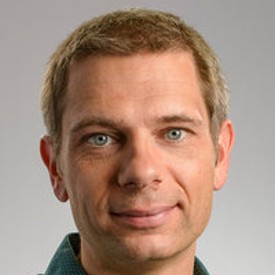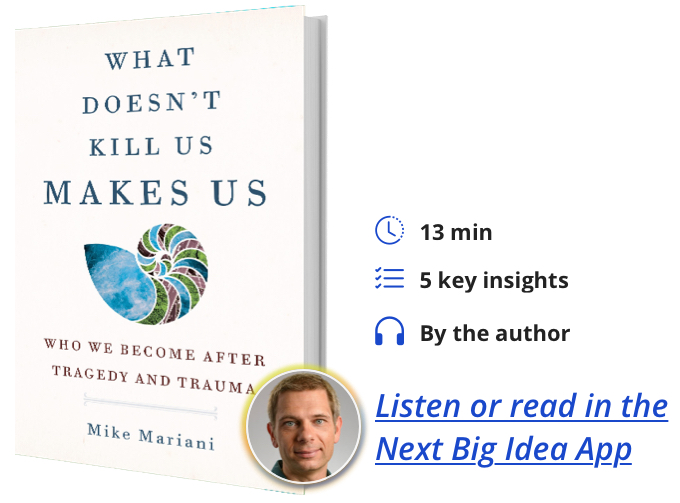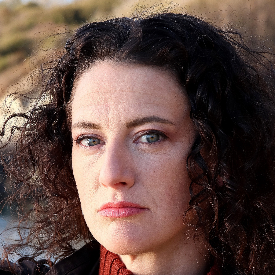Mike Mariani has worked as an English professor and freelance journalist, writing feature articles for The New Yorker, The Atlantic, The Guardian, Newsweek, GQ, Vanity Fair, and more.
Below, Mike shares 5 key insights from his new book, What Doesn’t Kill Us Makes Us: Who We Become After Tragedy and Trauma. Listen to the audio version—read by Mike himself—in the Next Big Idea App.
1. When we experience a life-changing event, we cannot simply “get back on the horse.”
People love talking about “getting back on the horse” after we face hardships and adversities—breakups, divorces, professional and financial setbacks. Friends, family, and peers often suggest that we just need to move on, get on with our lives, soldier through whatever adversities we’re grappling with. But for many (if not all) individuals negotiating the aftermath of a catastrophic life event—a major car accident, an acquired disability, the death of a child—there is no going back to the life they led before. They cannot “get back on the horse” because that horse is gone, and it is up to them to comb through the reconfigured landscape of their life in search of a new one.
After developing chronic fatigue syndrome, for example, I no longer had the physical energy and stamina to continue teaching English at the small college where I worked. I could not simply resume my preexisting life, because a body that had been irreversibly altered prevented me from doing so. Instead, I had to find another career path that was more manageable given my challenging constellation of new symptoms.
Similarly, after J.R. Vigil—one of the subjects in my book—was in a devastating car accident that left both of his legs amputated at the knee, he was forced to relinquish his fledgling career as a coffee-roasting entrepreneur, as well as his ardent passion for running. The horses both of us rode in on were gone, and it was up to us to strike out in search of new ones.
2. We typically think about our lives in terms of absolutes.
We subconsciously make certain assumptions about our lives that go something like this: “I will always be this type of person with this set of possible experiences and these parameters for what is possible. My life will never fall outside of those parameters and into the territory of people who’ve endured life-altering catastrophes, or unimaginable tragedy and trauma.”
“We should endeavor to think of all human experiences as possibilities for ourselves.”
We spare ourselves fear, paranoia, and dread when we can assign certain life events—long-term incarceration, paralysis, the sudden loss of a child—to the “never” category. Such experiences will never happen to us, we assure ourselves, thereby allowing us to maintain a sense of stability and continuity in our lives.
But creating these absolutes and the categories that reinforce them comes at a cost. When we create these “always” and “never” categories, we are cutting ourselves off from a huge part of the human experience, so that should something happen to us from the “never” category, we’ll be completely unprepared, and have no way to understand our new selves.
This is what often happens when people experience abrupt, life-changing events. They had relegated that experience to the “never” category in their minds, and had therefore never considered the possibility of it actually happening to them. As a result, they’re at a loss for how to begin to deal with it.
But if we stop thinking in terms of “always” and “never,” we can become more empathetic toward others and give ourselves a better understanding of how to deal with unexpected adversities. We should endeavor to think of all human experiences as possibilities for ourselves, and to not spurn those lives and circumstances we are most afraid of. Because when we marginalize in our minds those leading afterlives—due to our own fear, aversion, or some misguided sense of self-preservation—their marginalization within society inevitably follows.
3. The changes that we experience after life-altering catastrophes are not separate, discrete, and linear. They’re often intertwined and fascinating, and sometimes even redemptive.
One of the most interesting takeaways from my reporting into afterlives was discovering the densely interconnected nature of how we change following catastrophes. For example, while injury or illness can leave you in a state of solitude, that solitude may also lead you to what I talk about in the book as “seeking”—searching for meaning or developing a better understanding of ourselves or our world, whether that be through philosophy, religion, or the pursuit of self-knowledge. Solitude creates the conditions for us to yearn, learn more, and strive to contextualize our circumstances.
While a catastrophe may bring about a diminishment in the territory of our lives, that diminishment may ultimately establish the conditions for a life that is, yes, narrower, but also deeper. We may experience a substantial diminishment in the scope of what is possible in our lives, but that diminishment can pave the way for a powerful refinement in our priorities, simplifying and reforming our lives. This, in turn, can lead us to a state of devotion to a cause or craft.
“Solitude creates the conditions for us to yearn, learn more, and strive to contextualize our circumstances.”
One of the six subjects of my book, Valerie Piro, is an excellent example of this process. The high school car accident that left her paralyzed from the waist down was undoubtedly a colossal diminishment. It also, however, created the conditions for a process of refinement, one in which she sheared away many of the things that typically occupy a teenager’s time. Following this refinement of her priorities and lifestyle, Valerie embraced a state of devotion to her chosen academic discipline: medieval studies. And only through this state of devotion could she arrive at the place where we find her at the end of the book, as the first wheelchair user to ever be enrolled in Princeton’s graduate school of history.
4. Afterlives are all around us.
“Afterlives” is a term I use to describe the “after” period of a before-and-after event that cleaved someone’s life in half. People who experience the life-altering events I discuss in my book might be understood as members of invisible kingdoms relegated to society’s furthest margins—but the reality is that afterlives constitute a major portion of the human population.
Over a quarter of the U.S. adult population lives with a physical disability, most of which have been acquired over the course of their lifetimes. Around 300,000 Americans have suffered a spinal cord injury, and over five million are living with some form of paralysis. Two million Americans have lost one or multiple limbs, nearly 12 percent of Americans over the age of 50 have lost a child, and 20 million of us will endure an event distressing enough to leave us with post-traumatic stress disorder.
Part of my goal with this book is to make these invisible kingdoms visible, to expose readers to the varieties of catastrophe that can and do happen all the time to nearly anyone. My hope is that by illuminating these lives—and in particular, the six central subjects of the book—I will help facilitate an integration process, whereby we let go of our absolutes and embrace a more inclusive continuum of human experience.
5. Choose amor fati over “what doesn’t kill me makes me stronger.”
While Nietzsche is famous for the maxim on which the book’s title is based, “what doesn’t kill me makes me stronger,” perhaps the more applicable and dependable concept for those of us living afterlives is his idea of amor fati, or “love of one’s fate.”
“It requires the intellectual rigor to mine our lives and unearth the web of cause and effect that encompasses everything in it.”
Nietzsche and his predecessors, including the Greek Stoics, saw the philosophical idea of amor fati as a form of unconditional acceptance, an attitude that trades the futility of hypotheticals, what-ifs, and if-onlys for gratitude and amazement before the irrevocable trajectory of one’s fate. Instead of lamenting what might have been or how one’s life could have played out differently, proponents of amor fati embrace everything in their existence exactly as it is. The love within amor fati is also an analytical one, probing our misfortunes for the seeds that would later bloom into what we cherish most about our identities. There is simply no extricating the good from the bad, because they are perpetually creating one another. If we appreciate anything about our existence, amor fati tells us, we must appreciate everything.
Amor fati is, of course, a more difficult concept to grasp and embrace than the simple idea that “what doesn’t kill us makes us stronger.” It requires the intellectual rigor to mine our lives and unearth the web of cause and effect that encompasses everything in it. But subscribing to amor fati also gives us the opportunity to look at our lives with greater honesty, allowing us to accept more of the painful, inconvenient truths about our biographies without reflexively transforming them into evidence of our inner strength.
By unconditionally embracing our fate, we are able to access and accept a more nuanced, multifaceted portrait of our identities, one that does not rely too heavily on glorified ideas about strength and resilience. We can learn to exist as we are, and to see the connections between all aspects of our lives as necessary parts of our identity.
To listen to the audio version read by author Mike Mariani, download the Next Big Idea App today:

































